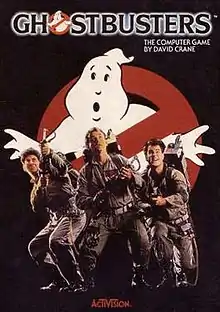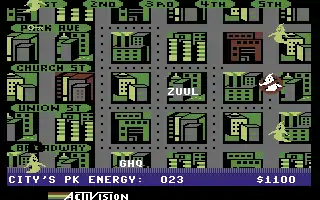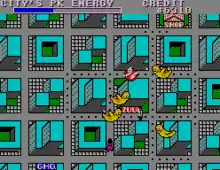Ghostbusters (1984 video game)
Ghostbusters is a licensed game by Activision based on the movie of the same name. It was designed by David Crane, produced by Brad Fregger, and released for several home computer platforms in 1984, and later for video game console systems, including the Atari 2600, Master System and NES. The primary target platform was the Commodore 64 and the programmer for the initial version of the game was Adam Bellin. All versions of the game were released in the USA except for the Amstrad CPC and ZX Spectrum versions, which were released only in Europe, and the MSX version, which was released only in Europe, South America, and Japan.
| Ghostbusters | |
|---|---|
 | |
| Developer(s) | Activision James Software Ltd. (Amstrad CPC, ZX Spectrum) Bits Laboratory (NES) Compile (Master System) |
| Publisher(s) | Activision Tokuma Shoten Publishing Co., Ltd.(Famicom, Japan) Sega (Master System) |
| Designer(s) | David Crane (Commodore 64) Robert McNally (Apple II) Glyn Anderson (Atari 8-bit) Robert Rutkowski (MSX, IBM PCjr/Tandy 1000) Dan Kitchen (Atari 2600) |
| Composer(s) | Russell Lieblich (Commodore 64, Apple II) Tadashi Sou (NES) Tohru Nakabayashi (Master System) |
| Platform(s) | Commodore 64, Apple II, Atari 8-bit, MSX, IBM PCjr/Tandy 1000, Atari 2600, Amstrad CPC, ZX Spectrum, NES/Famicom, Master System |
| Release | Commodore 64 1984 Apple II 1984 Atari 8-bit 1984 MSX 1984 IBM PCjr/Tandy 1000 1985 Atari 2600 1985 Amstrad CPC
Master System |
| Genre(s) | Action-adventure |
| Mode(s) | Single player |
In 1984, after the film Ghostbusters had been launched, John Dolgen VP of Business Development at Columbia Pictures approached Gregory Fischbach (President of Activision International and subsequently CEO and Co-founder of Acclaim Entertainment) and offered to license the game rights to Activision without specific rules or requests for the design or content of the game, only stipulating that it was to be finished as quickly as possible in order to be released while the movie was at peak popularity. Activision was forced to complete the programming work in only six weeks in contrast to their usual several months of development time for a game. Activision had at the time a rough concept for a driving/maze game to be called "Car Wars", and it was decided to build the Ghostbusters game from it. The effort paid off as both the movie and the game proved to be huge successes.[1]
Gameplay

The player sets up a ghost busting franchise in a city with a rising Psychokinetic (PK) Energy level and has the ability to purchase equipment such as traps, or to upgrade their vehicle. The player then negotiates a grid representing the city. They need to stop the "roamers" from reaching the temple of Zuul (which causes the PK Energy level to jump). When the player moves to a city block that is flashing red, the game mode switches to an overhead view of the player's vehicle driving to the location. The player must move left and right to vacuum up the stray ghosts and avoid cars. The player then moves to a screen in which a Slimer ghost must be guided with two proton streams over a ghost trap.
If the ghost is successfully captured, the player's income increases. The aim is to have $10,000 by the time the city's PK level reaches 9999, where in the Stay-Puft Marshmallow Man will appear and wreak havoc on the city, thereby ending the game. In some versions (e.g. the Commodore 64 version), after the first successful game, the player is given an account number, which stores the amount of money the player had at the end of the game. This allowed for purchasing more expensive items for use (faster cars, more traps etc.). In order to win at these games the player was required to have earned more money than their initial account balance. This is one of the earliest uses of passwords being used as a 'save game' feature on home computers.
Speech samples
Most versions of the game feature a sampled rendition of the "Ghostbusters!" cry at the start of the movie's theme song; on the C64 and Atari 8bit versions, this was produced within the game using a patented form of compression similar to ADPCM by ESS (Electronic Speech Systems), all without requiring external hardware to produce the speech. The PCjr/Tandy port does not have this feature.
Nintendo Entertainment System and Sega Master System versions

The game was also released on the Nintendo Entertainment System in 1986 in Japan and in 1988 in North America. These versions featured added gameplay after the Ghostbusters sneak by the Marshmallow Man. It played more like a conventional vertical scrolling platform game, where they were able to actually climb the stairs to get to the roof. However, the Ghostbusters could not fire their weapons nor trap any of the ghosts and had to instead sneak by all the floors. The NES version is considered the most difficult for this reason. At the end of the NES version, the final screen states: "Conglaturation!!! [sic] You have completed a great game. And prooved [sic] the justice of our culture. Now go and rest our heroes!". The Japanese version contains a bug that prohibits the ending to display, and instead resulting in the text "りり" (Riri) to appear on the left of the screen.
The game was also ported to the Sega Master System and released in 1987. Similar to the NES version, it features the staircase level, except the Ghostbusters are able to shoot the ghosts with their proton streams to temporarily make them go away. This version, while considered superior to the NES version, doesn't feature the speech sample and Gozer is mistranslated as "Gorza".
Reception
| Publication | Score |
|---|---|
| Crash | 60%[2] |
| CVG | 33/40[3] |
| Sinclair User | 7/10[4] |
| Your Sinclair | 8/10[5] |
| Home Computing Weekly | |
| ZX Computing | 6/10[7] |
| Sinclair Programs | 40%[8] |
Antic in May 1985 called Ghostbusters "the first adaptation to capture both the feel and the theme of the movie on which it is based ... most enjoyable to play".[9] Edge in 2007 called Ghostbusters "dauntingly good", noting that despite the action sequences expected of a licensed title, the game was a "polished, intelligently-paced", strategic business simulation.[10] Ernie Hudson said, "My kids really hated [the Commodore 64 game]. They thought it sucked."[11] In 1985 it and The Print Shop were reportedly the two most widely pirated Commodore 64 programs.[12] II Computing listed Ghostbusters eighth on the magazine's list of top Apple II games as of late 1985, based on sales and market-share data,[13] and it was Activision's best-selling Commodore game as of late 1987.[14]
The Amstrad CPC and ZX Spectrum versions of the game was included on the 1986 compilation They Sold a Million 3,[15][16] along with Fighter Pilot, Rambo and Kung-Fu Master. The game was also released on The Story So Far Volume IV in December 1989, and Hollywood Collection in December 1990. It knocked Daley Thompson's Decathlon from the top of the UK Spectrum sales chart.[17]
Ghostbusters was ported to the IBM PCjr and Tandy 1000 in 1985. Due to timing-sensitive raster effects the game uses, it is incompatible with Tandy machines other than the 1000/1000A, 1000HX, and 1000EX, all of which use a 4.77Mhz 8088 CPU.[18]
Reviews
- Computer and Video Games - Aug, 1989
- VideoGames - Mar, 1991
- Your Commodore - Apr, 1985
- ASM (Aktueller Software Markt) - Mar, 1987
- ACE (Advanced Computer Entertainment) - Jan, 1990
References
- "Richard Camfield - Retro Gamer". Retrogamer.net. Retrieved 4 January 2019.
- "World of Spectrum - Archive - Magazine viewer". Worldofspectrum.org. Retrieved 30 October 2014.
- "World of Spectrum - Archive - Magazine viewer". Worldofspectrum.org. Retrieved 30 October 2014.
- "World of Spectrum - Archive - Magazine viewer". Worldofspectrum.org. Retrieved 30 October 2014.
- "Ghostbusters". Ysrnry.co.uk. Archived from the original on 1 January 2016. Retrieved 30 October 2014.
- "World of Spectrum - Archive - Magazine viewer". Worldofspectrum.org. Retrieved 30 October 2014.
- "World of Spectrum - Archive - Magazine viewer". Worldofspectrum.org. Retrieved 30 October 2014.
- "World of Spectrum - Archive - Magazine viewer". Worldofspectrum.org. Retrieved 30 October 2014.
- Bernstein, Harvey (May 1985). "Ghostbusters". Antic. p. 81. Retrieved 8 January 2015.
- Edge (2007-05-04). "The Making of Ghostbusters". Next Generation. Archived from the original on 28 October 2011. Retrieved 14 August 2007.
- Ellie Gibson (10 July 2008). "Eurogamer: Ghostbusters' Ernie Hudson Interview". Eurogamer.net. Retrieved 30 October 2014.
- Peterson, Cheryl (August 1985). "Editorial". Ahoy!. p. 5. Retrieved 27 June 2014.
- Ciraolo, Michael (Oct–Nov 1985). "Top Software / A List of Favorites". II Computing. p. 51. Retrieved 28 January 2015.
- Ferrell, Keith (December 1987). "The Commodore Games That Live On And On". Compute's Gazette. pp. 18–22. Retrieved 24 January 2015.
- "They Sold a Million 3 - World of Spectrum". Worldofspectrum.org. Retrieved 30 October 2014.
- "They Sold a Million 3 for Amstrad CPC (1986) - MobyGames". MobyGames. Retrieved 30 October 2014.
- "World of Spectrum - Archive - Magazine viewer". Worldofspectrum.org. Retrieved 30 October 2014.
- "VOGONS • View topic - Ghostbusters". www.vogons.org. Retrieved 4 January 2019.
External links
- Ghostbusters at MobyGames
- Legends of the C64 article on David Crane (with Ghostbusters info)
- Speech Box - dedicated area to Commodore 64 speech (inc. Ghostbusters)
- All versions of the Ghostbusters games from The Movie Game Database
- Ghostbusters at SpectrumComputing.co.uk
- Review in Computer Gamer
- Review in Your Sinclair
- Review in Antic
- Review in Commodore Power/Play
- Review in ANALOG Computing
- Review in Page 6
- Review in Page 6